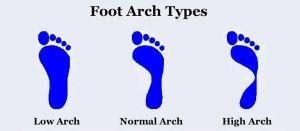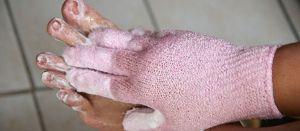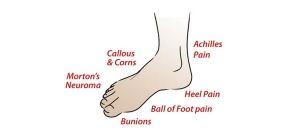High arch foot
Most people have an arch along the inner side of the foot, leaving a gap between the ground and the foot. Some feet have a higher arch than average. This is the opposite of a flatfoot. In combination with a higher arch, the ankle may be "rolled" outwards slightly - this is the opposite of a pronated foot. Often this gets referred to as pes cavus.
What does a high arch foot look like?
When standing with weight on the foot, the arch will appear higher. The heel often tilted inwards at the ankle (but not always). In many the toes will appeared clawed. When not standing the front half of the foot (forefoot) will appear to be dropped below the level of the rearfoot.
What causes high arch feet?
High arch feet may just be a normal variant (ie some people just have higher arches), some may be hereditary (ie runs in the family) and in some cases there may be an underlying neurological problem that is causing it.
What are the symptoms of a high arch foot?
The symptoms of a high arch foot will vary depending on how severe the condition is and the activity levels of the person with it. Most will have no pain or any other symptoms. Symptoms may vary from a mild problem with shoe fitting to significant disability.
Some of the symptoms can include:
- there may be corns and calluses under the bases of the first and fifth toes.
- Shoe may not fit very well because of the high arch and the clawed toes.
- There may be some pain in the arch area, because of the pressure that it is under.
- The feet will feel stiffer and less mobile than a foot that does not have a high arch.
- An ankle sprain are more common in those with a high arched foot.
How is the high arched foot treated?
This will depend on what is causing the pain, if anything. Initially a careful investigation is needed to rule out any neurological condition is causing the high arched foot.
Generally, treatment can involve:
The use of foot orthotics or insoles to support and protect the foot and relieve pressure areas.
Different sorts of pads made from silicone or felt can be used to get pressure off the painful areas
- If corns and callus are present, they can be treated by a Podiatrist.
- Proper fitting of footwear is important.
- In very sever cases, especially if pain is present and the height of the arch is progressively increasing in height, surgery may be considered.
Take the Wet Test: Learn Your Foot Type
A simple wet test can tell you if you have flat or high arches, and how to choose your running shoes accordingly.
How to Care for Your Feet and Toenails
Your feet are two of the most abused and often used parts of the body, what with all the walking and running that you do everyday. This being said, you should make sure to give your feet the attention and care they deserve every so often.
Flat Feet Causes and Prevention
Flat feet is also know as pes planus, adult acquired flat foot deformity, progressive flat foot deformity, posterior tibial tendon dysfunction (PTTD), flat foot, splay foot, fallen arches (loss of medial longitudinal arch of foot).
8 Common Foot Problems
Fungal and Bacterial Conditions, including athlete's foot, occur because our feet spend a lot of time in shoes - a warm, dark, humid place that is perfect for fungus to grow. Fungal and bacterial conditions can cause dry skin, redness, blisters, itching, and peeling.
With the intelligent insole your toe bone really is connected to your foot bone
The old American spiritual had it right, the toe bone is connected to the foot bone, the foot bone's connected to the heel bone, the heel bone's connected to the anklebone and so on through the length of the human body. But these days it's not Ezekiel who's joining up dem dry bones but the Internet of Things (IoT) and a UK-headquartered company HCi Viocare Technologies, the inventor of the Smart Insole.
Palm Beach Podiatry Website Offers Breakthrough Information in Foot Care
Anyone battling foot or ankle pain knows that finding a good doctor is paramount for getting the right treatment for the right problem. Websites are a good source of information when searching for a podiatrist, but Palm Beach Podiatry has launched its website with more than just a wealth of information about its background and services. Because the doctors at Palm Beach Podiatry are serious about patient relationships, they wanted their website to reflect their commitment to staying up to speed on foot care research and development across the globe.
Diabetes-related amputations on the rise
The number of people with diabetes who had to have lower limbs amputated as a result of the condition increased last year, despite the fact that such amputations are almost completely preventable, Diabetes Ireland has warned.






